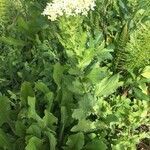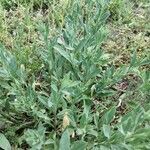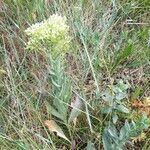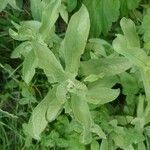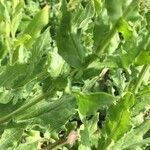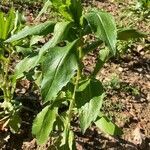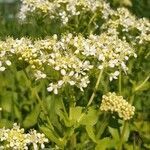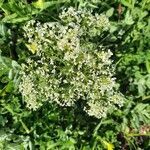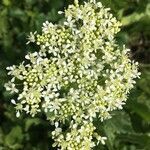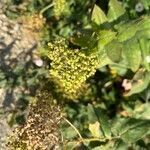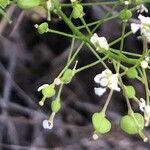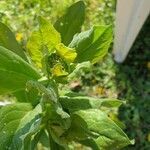Perennial herb 15–90 cm high, procumbent to erect, pubescent; root system producing adventitious buds. Leaves simple; basal leaves petiolate, blade obovate to elliptic, oblanceolate or oblong-ovate, to 10 (–15) cm long, cuneate, scalloped, toothed or entire; cauline leaves sessile, stem-clasping, obovate to ovate-oblong, sinuate-dentate or broadly toothed. Sepals 1.5–2 mm long, spreading, non-saccate. Petals 3–4 mm long, white, clawed. Stamens 6. Nectariferous glands 6; medians 2, triangular; laterals 4, semilunate. Style evident, 1–2 mm long, persistent, stigma capitate. Silicula cordate, inflated, 3–5 mm long, 3.5–5 mm wide, obtuse to rounded, not notched, smooth; valves constricted basally to narrow septum; indehiscent, separating into 1-or 2-seeded articles; pedicels 4–15 mm long. Seeds oval, c. 2 mm long, mucilaginous; radicle incumbent.
Erect herbs with annual shoots from a perennial root, 15-60(-90) cm high, finely retrorsely puberulous in the lower half, glabrous above. Basal leaves dying off soon, petiolate, ± obovate, sublyrate or sinuately lobed, sometimes ± canescent. Stem leaves up to 10 cm long, ovate-oblong, sessile, sagittate, amplexicaul, acute, sinuate-dentate, the lower ones thinly puberulous on the lower surface, the upper ones glabrous. Inflorescence dense. Sepals 1.5-2 mm long. Petals 3-4 mm long, obovate, clawed, white. Siliculae on c. 1 cm long, ± reflexed or horizontally spreading pedicels, 3-4.5 mm long, 3.5-5 mm broad, obcordate, inflated, indehiscent, the valves faintly reticulate; style 1-1.5 mm long, slender; stigma capitate. Seeds 2-2.25 x 1.2-1.5 mm, subcompressed, almost smooth, immarginate.
Perennial herb, up to 0.9 m high. Stems erect, several annually from rootstock; finely retrorsely puberulous in lower half, glabrous above. Leaves with basal ones dying off soon, petiolate; blade obovate, sublyrate or sinuately lobed; stem leaves sessile, ovate-oblong, up to 100 mm long, amplexicaul, base sagittate, apex acute, margins sinuate, dentate, the lower ones thinly puberulous on lower surface, upper ones glabrous. Flowers: in a dense, ebracteate, corymbose panicle; sepals 1.5-2.0 long; petals obovate, 3-4 mm long, white; Nov.-Feb. Fruit with pedicels ± reflexed or horizontally spreading; siliquae obcordate, 3.0-4.5 mm long, inflated.
Perennial herb, 0.15-0.90 m high, erect, finely retrorsely puberulous in lower half, glabrous in upper half. Leaves: basal leaves petiolate, sublyrate or sinuately lobed, sometimes canescent, obovate; cauline leaves sessile, sagittate, lower ones puberulous in lower surface, upper ones glabrous, ovate-oblong, sinuate-dentate. Inflorescence a dense panicle. Flowers white, sweetly scented. Petals obovate, clawed, white. Fruit a siliqua, inflated, obcordate, indehiscent, valves faintly reticulate. Seeds almost smooth, subcompressed, emarginate.
A cabbage family herb. It keeps growing from year to year. The leaves are oblong and pale grey-green. They are 3-10 cm long by 1-4 cm wide. They have small teeth and curved spines. The flowers are small and white in dense clusters.
